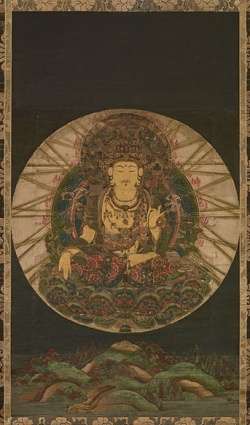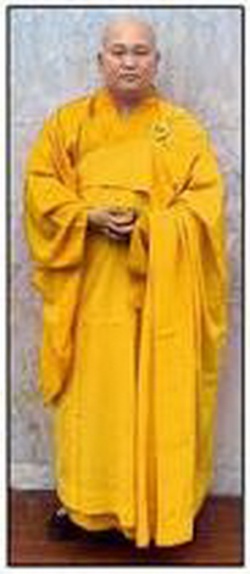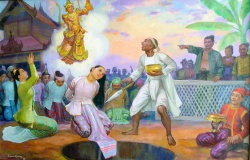Nam-myoho-renge-kyo
Nichiren (1222-82) established the chanting of Nam-myoho-renge-kyo as the way to awaken one's Buddha nature and tap into the deepest levels of our existence, on which our own lives and that of the universe are one.
He first taught the invocation of the phrase to a small group at Seicho-ji temple in Awa province, Japan, on April 28, 1253.
Myoho-renge-kyo is the name of the Lotus Sutra in Japanese pronunciation of classical Chinese characters, and so the literal meaning of Nam-myoho-renge-kyo is "I devote myself to the Lotus Sutra."
As the following explanation shows, there are deeper levels of meaning attached to each element of the phrase.
==Nam==
Nam derives from the Sanskrit word namu, meaning "to devote oneself." Nichiren established the practice of chanting Nam-myoho-renge-kyo as a means to enable all people to put their lives in harmony or rhythm with the law of life, or Dharma.
In the original Sanskrit, namu indicates the elements of action and attitude, and refers therefore to the correct action one needs to take and the attitude one needs to develop in order to attain Buddhahood in this lifetime.
==Myoho==
Myoho literally means the Mystic Law--the underlying truth or principle which governs the mysterious workings of the universe and our life from moment to moment.
Myo refers to the very essence of life, which is "invisible" and beyond intellectual understanding.
This essence always expresses itself in a tangible form (ho) that can be apprehended by the senses.
Phenomena (ho) are changeable, but pervading all such phenomena is a constant reality known as myo.
Myo also means to open, to revive, and to be fully endowed with the qualities we need to develop our lives.
==Renge==
Nam-myoho-renge-kyo Renge means lotus flower.
The lotus blooms and produces seeds at the same time, and thus represents the simultaneity of cause and effect.
The circumstances and quality of our individual lives are determined by the causes and effects, both good and bad, that we accumulate (through our thoughts, words and actions) at each moment.
This is called our "karma."
The law of cause and effect affirms that we each have personal responsibility for our own destiny.
We create our destiny and we have the power to change it.
The most powerful positive cause we can make is to chant Nam-myoho-renge-kyo; the effect of Buddhahood is simultaneously created in the depths of our life and will definitely manifest in time.
The lotus flower grows and blooms in a muddy pond, and yet remains pristine and free from any defilement, symbolizing the emergence of Buddhahood from within the life of an ordinary person in the midst of the struggles of day-to-day existence.
==Kyo==
Kyo literally means sutra, the voice or teaching of a Buddha.
In this sense, it also means sound, rhythm or vibration.
In a broad sense, kyo conveys the concept that all things in the universe are a manifestation of the Mystic Law.




